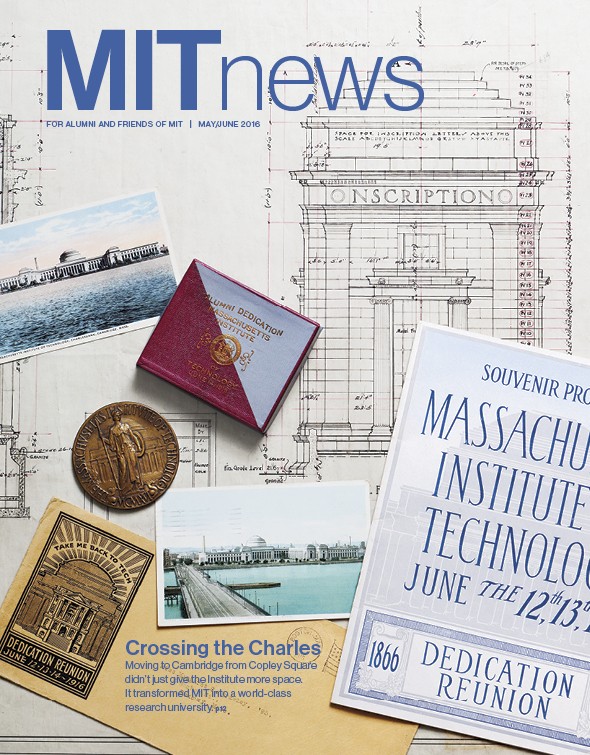Letters
Crossing the Charles
One of the great joys of working on the Collections Committee of the MIT Museum for the past 14 years has been getting to know and work with the amazing Deborah G. Douglas, director of collections and curator of science and technology at the museum. Debbie is an incredible dynamo with an encyclopedic knowledge of the history of science and technology and a boundless passion for MIT’s role in so many facets of these evolving disciplines. She authored the book Countless Connecting Threads: MIT’s History Revealed Through Its Most Evocative Objects, inspired by an exhibition that she curated for MIT’s 150th anniversary.

Debbie’s article “The Move That Shaped MIT” (May/June 2016) is a fascinating story about the historic move from Copley Square in Boston to Kendall Square in Cambridge—the work of an extraordinary, diverse group of individuals who dared to dream great dreams and put in the effort to make these dreams a reality. In an era when attention spans are tiny and the world often focuses on the latest monthly results, this kind of long-term vision seems to be very rare.
The planning for the “New Technology” set a tone that continues to this day as plans get under way to transform and revitalize Kendall Square, including a new MIT Museum right at the heart of the square. I am sure that Debbie will play a significant role in this visionary project.
Martin Klein ’62
Andover, Massachusetts
Electric Vehicles’ Operating Costs
In “Will We Ever Stop Using Fossil Fuels?” (May/June 2016) Peter Dizikes reports on a study coauthored by Professor Christopher Knittel, telling us, “High battery costs mean the price of oil would need to exceed $350 per barrel to make an electric vehicle cheaper to operate than a conventional one right now.” He is way off the mark! Try telling this to the 500,000 customers who have either bought or made a deposit on a Tesla car already. The correct number is probably close to $70 per barrel and falling every year.
Nick Fast ’53
Hilton Head Island, South Carolina
Professor Knittel responds:
What explains the 500,000 people who “ordered” the Tesla 3? First, those who buy Teslas can receive roughly $10,000 in subsidies. Those subsidies are not “free,” and economists agree that they should not be included in the social cost of a product. Second, people who reserved the Tesla 3 only had to put up a refundable $1,000. Therefore, the only cost of backing out of the commitment is the interest that would have been earned on the $1,000—essentially zero. Third, roughly 16 million vehicles are sold each year in the U.S. Our calculations are for electric vehicles to replace those with internal-combustion engines, not for them to be a niche market. And finally, our calculations are based on a very simple spreadsheet that I am happy to share so readers can understand what goes into the $350 number. (View the spreadsheet at technologyreview.com/EV-price.)
An Innovative President
It is far too early for accolades, but President Reif’s commentary on diversity in the current issue of MIT Technology Review (“A More Welcoming MIT,” May/June 2016) is a bell ringer.
It is hard to believe he is starting his fifth year in the oval office at MIT on July 1, 2016. Thank heaven he is not graduating with the Class of 2016.
The 17th president in the long gray line seems to innovate on a daily and weekly basis. The meeting of the Academic Council with students is one example. The meeting of the Executive Committee in Singapore is another. His enthusiasm for MIT is infectious, from the far reaches of the campus to the global hinterlands.
How can we adequately thank President Reif and first lady Christine for bringing their leadership qualities to the Institute? They have made 17 our lucky number!
Vincent A. Fulmer, SM ’53
Arlington, Massachusetts
Whirlwind Memories
“The Many Careers of Jay Forrester” (July/August 2015) brought back many pleasant memories. In 1951, when I began my studies at MIT for a master’s in electrical engineering, I was a research assistant on the Whirlwind project. The assignment for our group, led by Chuck Corderman and Pat Youtz, was to understand, build, and improve the memory system already in use on the Whirlwind I computer. This system didn’t use vacuum tubes for storage; it used made-to-order cathode ray tubes with a precision deflection system and an added electron gun to “spray” and hold the pattern of bits (normally 1,024 bits) on the internal face of the tube. When I left MIT, it was with my diploma in one hand and a full-size storage tube (which had been “de-vacuumed” for safety) in the other, as a memento of the rapid pace of change in technology.
Herman Jacobowitz, SM ’52
Philadelphia
Tell us what you think
E-mail mitnews@technologyreview.com
Write MIT News, One Main Street, 13th Floor, Cambridge, MA, 02142
Keep Reading
Most Popular
Large language models can do jaw-dropping things. But nobody knows exactly why.
And that's a problem. Figuring it out is one of the biggest scientific puzzles of our time and a crucial step towards controlling more powerful future models.
How scientists traced a mysterious covid case back to six toilets
When wastewater surveillance turns into a hunt for a single infected individual, the ethics get tricky.
The problem with plug-in hybrids? Their drivers.
Plug-in hybrids are often sold as a transition to EVs, but new data from Europe shows we’re still underestimating the emissions they produce.
Google DeepMind’s new generative model makes Super Mario–like games from scratch
Genie learns how to control games by watching hours and hours of video. It could help train next-gen robots too.
Stay connected
Get the latest updates from
MIT Technology Review
Discover special offers, top stories, upcoming events, and more.